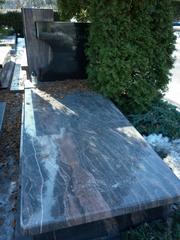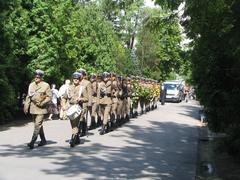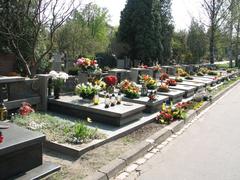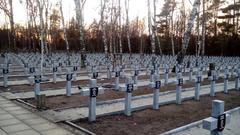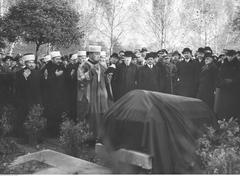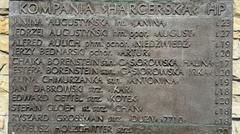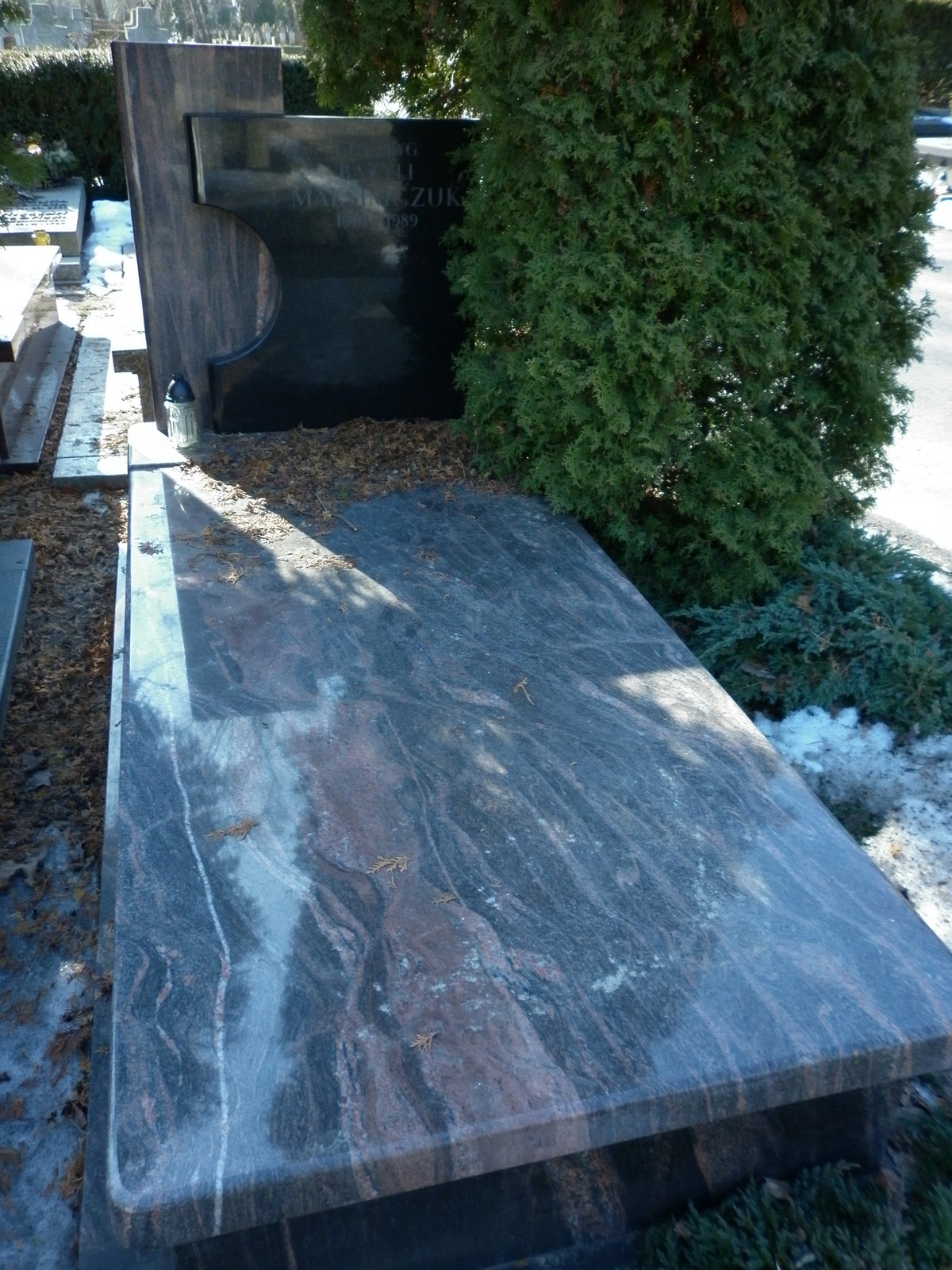
Powązki Military Cemetery Warsaw: Visiting Hours, Tickets, and Comprehensive Visitor Guide
Date: 14/06/2025
Introduction: The Legacy of Powązki Military Cemetery
Powązki Military Cemetery (Cmentarz Wojskowy na Powązkach) is one of Poland’s most honored sites of remembrance, located in Warsaw’s Żoliborz district. Established in 1912 during the era of partition, the cemetery has evolved from its original role as a burial ground for Tsarist Russian soldiers into Poland’s national necropolis. Today, Powązki is a revered memorial for soldiers, resistance fighters, statesmen, artists, and victims of oppression—serving as a poignant chronicle of the nation’s turbulent 19th and 20th centuries. Its grounds are not only a resting place for heroes and martyrs but also an open-air gallery of Polish funerary art and national symbolism. The cemetery’s 24 hectares house approximately 180 sections, making it a cornerstone of Warsaw’s historical landscape. (Wikipedia: Powązki Military Cemetery, ekompas.pl, Warsaw Institute)
Contents
- Origins and Early Development
- Interwar Period and Early Burials
- World War II and the Warsaw Uprising
- Postwar Period and the “Łączka” Section
- Notable Burials and Memorials
- Architectural and Artistic Features
- Visiting Information: Hours, Tickets, and Accessibility
- Guided Tours and Special Events
- Visitor Etiquette and Tips
- Nearby Attractions
- Frequently Asked Questions (FAQ)
- Summary and Final Thoughts
- References
Origins and Early Development
Powązki Military Cemetery was established in 1912 as an annex to the historic Catholic Powązki Cemetery (dating back to 1790). Its initial purpose was to serve as a burial ground for Russian soldiers stationed in Warsaw during the partition period. After Poland regained its independence in 1918, the cemetery was redefined as a national necropolis, dedicated to soldiers and citizens who contributed to the newly sovereign state. This transformation marked the beginning of Powązki’s enduring role as a site of public memory and national identity. (Wikipedia: Powązki Military Cemetery, ekompas.pl)
Interwar Period and Early Burials
In the years between the World Wars, Powązki Military Cemetery became the final resting place for veterans of Poland’s struggles for independence, including those who fought in the Greater Poland Uprising, Polish–Soviet War, and the Polish–Ukrainian War. These burials reflected the diversity and sacrifice of the nation’s defenders, encompassing soldiers, officers, and civilians from various backgrounds. (ekompas.pl)
World War II and the Warsaw Uprising
The most significant chapter in Powązki’s history is entwined with the tragedy and heroism of World War II. The cemetery holds the graves of hundreds of soldiers, resistance members, and civilians who perished in the Warsaw Uprising of 1944—Europe’s largest urban resistance operation. The Gloria Victis (“Glory to the Vanquished”) Monument, erected in 1946, stands as the focal point for annual commemorations, especially the “W-Hour” event held every August 1st. Even during the communist period, when open commemoration was discouraged, the cemetery remained a site of silent defiance and patriotic remembrance. (Warsaw Institute, Wikipedia: Powązki Military Cemetery)
Postwar Period and the “Łączka” Section
Following World War II, Powązki Military Cemetery also became a burial site for victims of Stalinist repression. The “Łączka” (“the Meadow”) section, in particular, contains mass graves of anti-communist resistance fighters—known as the “Cursed Soldiers”—secretly buried between 1948 and 1956. For decades, these graves were unmarked and forgotten, only to be rediscovered and commemorated in the 1990s. Today, ongoing exhumations and identification efforts continue, and the “Łączka” serves as a national symbol of remembrance for those who fought for freedom in postwar Poland. (ekompas.pl)
Notable Burials and Memorials
Powązki Military Cemetery is the final resting place for a remarkable array of individuals:
- 19th-Century Uprising Veterans: Soldiers from the November (1830–1831) and January (1863–1864) uprisings.
- Victims of the Katyn Massacre: Polish officers murdered by the Soviet NKVD in 1940 are memorialized here.
- 2010 Smolensk Air Disaster Victims: Several officials from the tragic presidential plane crash are interred, with a dedicated monument.
- Prominent Figures: Mirosław Hermaszewski (the only Polish astronaut), General August Emil Fieldorf “Nil,” and Captain Witold Pilecki—both key resistance leaders—are commemorated, especially in the “Łączka” section.
Monuments and symbolic graves also pay tribute to the anonymous and missing, ensuring that the memory of all who sacrificed for Poland endures. (Find a Grave, Nobel Peace Summit)
Architectural and Artistic Features
Spanning 24 hectares and divided into around 180 sections, the cemetery blends traditional and modern styles. Monuments and tombstones were designed by some of Poland’s leading sculptors and architects, featuring motifs from neoclassical to modernist. The Gloria Victis Monument and the white granite Smolensk Disaster Memorial are among its most striking features. The landscaped setting, tree-lined avenues, and seasonal plantings create a reflective, solemn atmosphere. (Nobel Peace Summit)
Visiting Information: Hours, Tickets, and Accessibility
Visiting Hours
- Open daily:
- April–September: 8:00 AM – 6:00 PM
- October–March: 8:00 AM – 4:00 PM
- Hours may vary on public holidays; check current schedules before visiting.
Admission and Tickets
- Free entry for all visitors.
- No tickets are required for individual visits.
Location & Directions
- Address: ul. Powązkowska 43/45, Żoliborz, Warsaw
- Public transport: Easily reached by several tram and bus lines. The “Powązki-Cmentarz Wojskowy” tram stop is adjacent to the entrance.
- Parking: Limited parking is available nearby.
Accessibility
- Main avenues are paved and generally suitable for wheelchairs and strollers, though some older sections may have uneven terrain.
- Benches and rest areas are available throughout the grounds.
(Warsaw In Your Pocket, WarsawTour)
Guided Tours and Special Events
- Guided tours: Available in several languages from local operators and cultural institutions. Tours highlight the cemetery’s history, notable burials, and symbolic monuments.
- Commemorative events: Major events include:
- All Saints’ Day (November 1): Thousands of candles and visitors create a sea of light in tribute.
- Warsaw Uprising Anniversary (August 1): “W-Hour” ceremonies around the Gloria Victis Monument.
- Advance booking: Recommended for guided tours, especially during peak commemorative dates.
Visitor Etiquette and Tips
- Maintain silence and respect at all times.
- Dress modestly, especially if attending commemorative events.
- Stay on designated paths; do not walk on graves.
- Photography is permitted, but avoid photographing mourners or active ceremonies.
- Lighting a candle or leaving flowers is a traditional gesture of respect.
Nearby Attractions
While at Powązki Military Cemetery, visitors are encouraged to explore other key sites in Warsaw:
- Warsaw Uprising Museum
- Old Powązki Cemetery (historic graves and funerary art)
- POLIN Museum of the History of Polish Jews
- Old Town Warsaw
These locations provide further context to the stories and history preserved at Powązki.
Frequently Asked Questions (FAQ)
Q: What are the Powązki Military Cemetery visiting hours?
A: Open daily, 8:00 AM–6:00 PM (April–September), 8:00 AM–4:00 PM (October–March). Check for holiday changes.
Q: Is there an entrance fee or do I need tickets?
A: No, admission is free.
Q: Is the cemetery wheelchair accessible?
A: Main paths are accessible, but some sections may be uneven.
Q: Are guided tours available?
A: Yes, in several languages, often including other Warsaw historical sites.
Q: Can I take photographs?
A: Yes, but please be respectful and avoid photographing mourners or ceremonies.
Q: What is the best time to visit?
A: All Saints’ Day (for atmosphere), or weekday mornings for a quieter experience.
Summary and Final Thoughts
Powązki Military Cemetery is a powerful symbol of Poland’s resilience, sacrifice, and cultural legacy. Its grounds bear witness to the nation’s most pivotal moments—from uprisings and wars to periods of oppression and renewal. Whether you are a history buff, a cultural traveler, or simply wish to pay your respects, visiting Powązki offers a moving and enlightening experience. With free admission, accessible location, and the option of guided tours, the cemetery is welcoming to all. Annual commemorations, community initiatives, and ongoing conservation ensure that this vital site remains a living monument to the Polish spirit. To deepen your understanding, pair your visit with nearby historic sites and consider using audio guides available through platforms like Audiala.
(ekompas.pl, Warsaw Institute, WarsawTour)
References
- Wikipedia: Powązki Military Cemetery
- ekompas.pl
- Warsaw Institute
- Warsaw In Your Pocket
- Find a Grave
- Nobel Peace Summit
- WarsawTour
- Mazovia Regional Studies
- warrelics.eu
- Over the Planet
